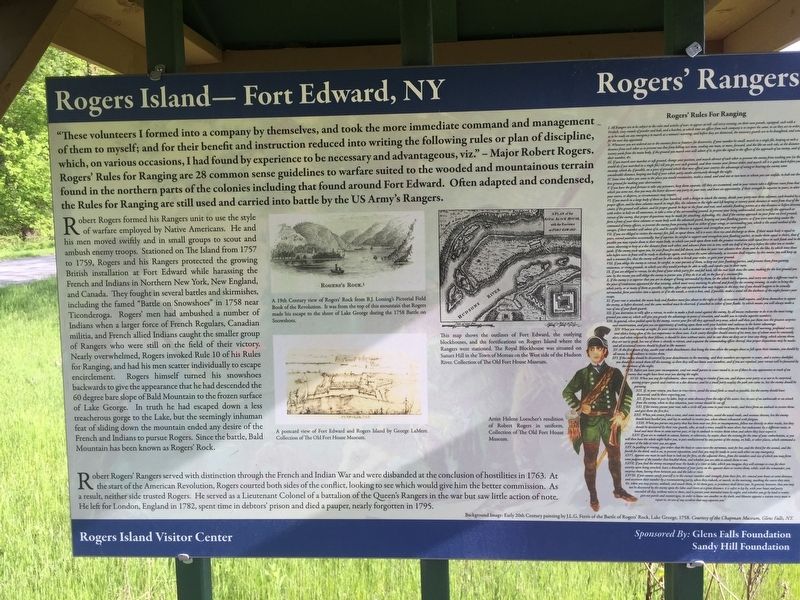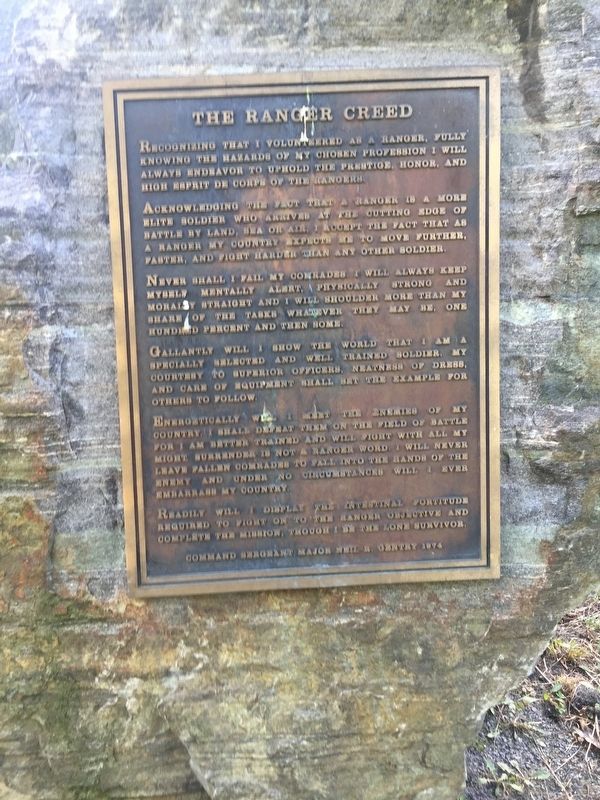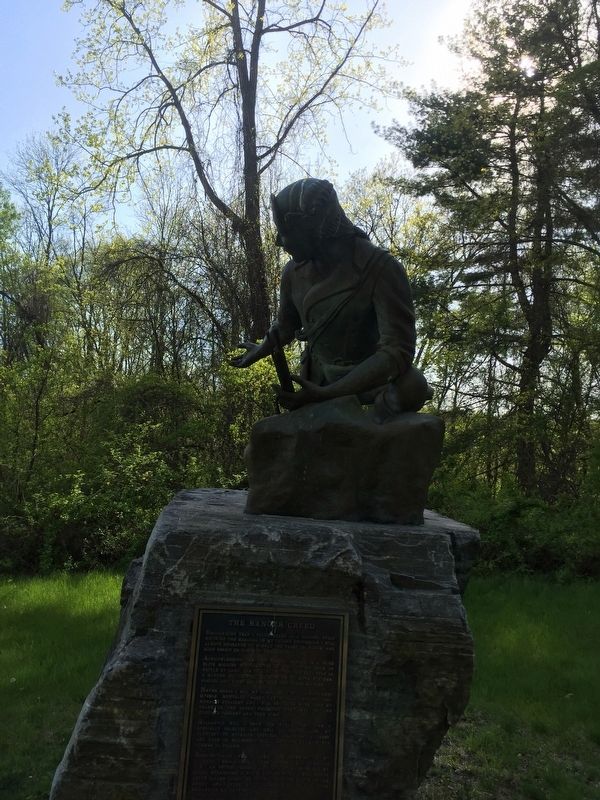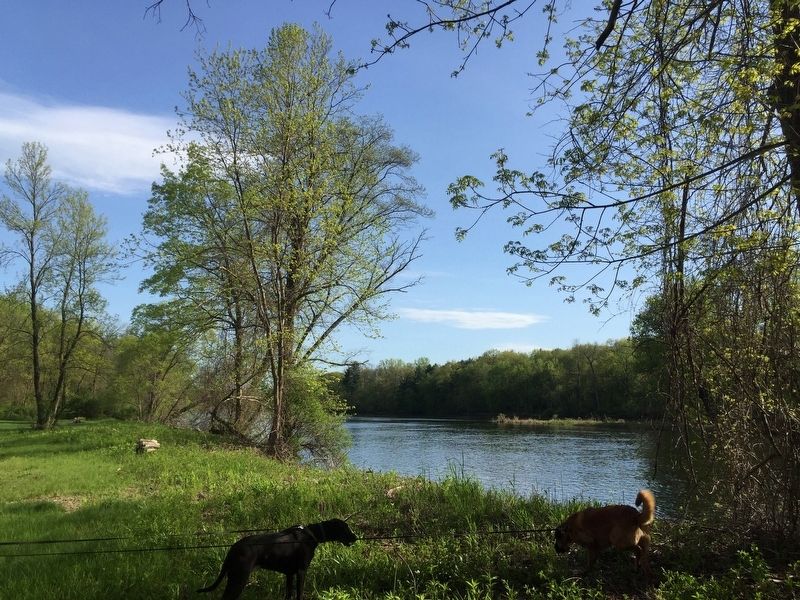Fort Edward in Washington County, New York — The American Northeast (Mid-Atlantic)
Rogers Island -- Fort Edward, NY
Rogers' Rangers
"These volunteers I formed into a company by themselves, and took the more immediate command and management of them to myself; and for their benefit and instruction reduced into writing the following rules or plan of discipline, which, on various occasions, I had found by experience to be necessary and advantageous, viz.” - Major Robert Rogers. Rogers' Rules for Ranging are 28 common sense guidelines to warfare suited to the wooded and mountainous terrain found in the northern parts of the colonies including that found around Fort Edward. Often adapted and condensed, the Rules for Ranging are still used and carried into battle by the US Army's Rangers.
Robert Rogers formed his Rangers unit to use the style of warfare employed by Native Americans. He and his men moved swiftly and in small groups to scout and ambush enemy troops. Stationed on The Island from 1757 to 1759, Rogers and his Rangers protected the growing British installation at Fort Edward while harassing the French and Indians in Northern New York, New England, and Canada. They fought in several battles and skirmishes, including the famed "Battle on Snowshoes” in 1758 near Ticonderoga. Rogers' men had ambushed a number of Indians when a larger force of French Regulars, Canadian militia, and French allied Indians caught the smaller group of Rangers who were still on the field of their victory Nearly overwhelmed, Rogers invoked Rule 10 of his Rules for Ranging, and had his men scatter individually to escape encirclement. Rogers himself turned his snowshoes backwards to give the appearance that he had descended the 60 degree bare slope of Bald Mountain to the frozen surface of Lake George. In truth he had escaped down a less treacherous gorge to the Lake, but the seemingly inhuman feat of sliding down the mountain ended any desire of the French and Indians to pursue Rogers. Since the battle, Bald Mountain has been known as Rogers' Rock.
Robert Rogers’ Rangers served with distinction through the French and Indian War and were disbanded at the conclusion of hostilities in 1763. At the start of the American Revolution, Rogers courted both sides of the conflict, looking to see which would give him the better commission. As a result, neither side trusted Rogers. He served as a Lieutenant Colonel of a battalion of the Queen's Rangers in the war but saw little action of note. He left for London, England in 1782, spent time in debtors' prison and died a pauper, nearly forgotten in 1795
Rogers' Rules For Ranging
I. All Rangers are to be subject to the rules and articles of war, to appear as roll call every evening, on their own parade, equipped, each with Firelock, sixty rounds of powder and ball, and a hatchet, at which time an officer from each company is to inspect the same, to see they are in order as to be ready on any emergency to march at a minute's warning; and before they are dismissed, the necessary guards are to be draughted and scouts for the next day appointed.
II. Whenever you are ordered out to the enemies forts or frontiers for discoveries, if your number be small, march in a single file, keeping at such a distance from each other as to prevent one shot from killing two men, sending one man, or more forward, and the like on each side, as the distance of twenty yards from the main body, if the ground you march over will admit of it, to give the signal to the officer of the approach of an enemy, and their number, etc.
III. If you march over marshes or soft ground, change your position, and march abreast each other to prevent the enemy from tracking you (as they would do if you marched in a single file) till you get such ground as will admit of it, and then resume your former order, and march till it is quite dark before you encamp, which do, if possible, on a piece of ground which that may afford your centuries the advantage of seeing or bearing the enemy some considerable distance, keeping one half of your whole party awake alternately through the night.
IV. Some time before you come to the place you would reconnoitre, make a stand, and send one or two men in whom you can confide, to look out the ground for making your observations.
V. If you have the good fortune to take any prisoners, keep them separate, till they are examined, and on your return take a different route from that which you went out, that you may the better discover any party in your rear, and have an opportunity, if their strength be superior to yours, to alternate your course, or disperse, as circumstances may require.
VI. If you march in a large body of three on four hundred with a design to attack the enemy, divide your party into three columns, each headed by an proper officer, and let those columns march single files, the columns to the left and right keeping as twenty yards distance or more from that of the center, if the grounds will admit, and let proper guards be he kept in the front and rear, and suitable flanking parties at a due distance as before directed with orders to halt at all eminences, so take a view of the surrounding ground to prevent your being ambuscaded, and to notify the approach or retreat of the enemy that proper dispositions may be made for attacking, defending, etc. And if the enemy approach in your front on level ground, form a front of your three columns of main body with the advanced guard. Keeping your flanking parties, as if you were marching under the command of trusty officers, to prevent the enemy farm pressing hand on either of your wing, or of your wings , or surrounding you, which is the usual method of the savages, if their number will permit it, and be careful to support and strengthen your rear guard.
VII. If you are obliged to receive the enemy's fire fall or squat down, till it is over, then rise and discharge at them. If their main body is equal to yours, extend yourselves occasionally , but if superior, be careful to support and strengthen your flanking parties to make them equal to theirs, that if possible you may repulse them to their main body, in which case push upon them with the greatest resolution with equal force in each flank and in center, observing to keep at a due distance from each other, and advance from tree to tree with one half of the party before the other ten or twenty yards. If the enemy push upon you, let your front fire and fall down, and then let your rear advance and do the like, by which time those who before were in front will be ready to discharge again, and repeat the same alternately as occasion shall require; by this means you will keep up a constant fire, that the enemy will not be able easily to break your order, or gain your ground.
VIII. If you oblige the enemy to retreat, be careful, in your pursuit of them, to keep out your flanking parties and prevent them from gaining eminences in which case they would perhaps be able to rally and repulse you in their turn.
IX. If you are obliged to retreat, let the front of your whole party fire and fall back, till the rear bath done the same, making for the best ground you can; by this means you can oblige the enemy to pursue you, if they do it at all in the face of s constant fire.
X. If the enemy so superior that you are in danger of being surrounded by them, let the whole body disperse, and everyone take a different road to the place of rendezvous appointed for that evening, which must every morning be altered and fixed for the evening ensuing, in order that to bring the whole party , or as many of them as possible, to together, after any separation that may happen in the day; but if you should happen to be actually surrounded, form yourselves into a square, or if in the weeds, a circle is best, and if possible, made a stand till the darkness of night favours yours escape.
XI. If your rear is attacked, the main body and flankers must face about to the right or left, at occasion shall require, and form themselves to oppose the enemy, as before directed; and the same method must be observed, if attacked in either of your flanks, by which means you will always make a rear of one of your flank-guards.
XII. If you determine to rally after a retreat, in order to a fresh start against the enemy, by all means endeavor to do it on the most rising ground you come at, which will give you greatly the advantage in point of situation, and enable you to repulse superior numbers.
XIII. In general, when pushed upon by the enemy, reserve your fire till they approach very near, which then put them into the greatest surprise and consternation, and give you an opportunity of rushing upon them with your hatchets and cutlasses to the better advantage.
XIV. When you encamp, at night, fix your centries in such a manner as not to be relieved from the main body till morning, profound secrecy and silence being often of the last importance of these cases. Each century therefore should consist of six men, two of whom must be constantly alert, and when relieved by the their fellows, it should be done without noise; and in case those on duty see or hear any thing, which alarms them they are not to speak, but one of them is silently to retreat, and acquaint the commanding officer thereof, that proper dispositions may be and all occasional centries should be fixed in like manner
XV. At the first dawn of day, awake your whole detachment; that being the time when the savages chuse to fall upon their enemies, you should at all means be in readiness to receive them.
XVI. If the enemy should be discovered by your detachments in the morning, and their numbers re superior to yours, and a victory doubtful, you should not attack them till the evening, as then they will not know your numbers, and if you are repulsed, your retreat will ne favored be the darkness of the night.
XVII. Before you leave your encampment, send out small parties to scout around it, to see if there be any appearance or track of an enemythat might have been near you during she night.
XVIII. When you stop for refreshment, chuse some spring or rivulet if you can, and dispose of your party so as not to be surprised, posting proper guards and centuries at due distance, and let a small party waylay the path you came in, let the enemy should be pursuing.
XIX. If, in your return, you have to cross rivers, avoid the usual fords as much as possible, lest the enemy should have discovered, and be they’re expecting you.
XX. If you have to pass by lakes, keep a some distance from the edge of the water, lest, in case of an ambuscade or an attack from the enemy, when in that situation your retreat should be cut off.
XXI. If the enemy pursue your rear, take a circle till you come to your own tracks, and therefore an ambush to receive them, and give them the first fire.
XXII. When you return from a scout, and come near our forts, avoid the usual roads, and avenues thereto, less the enemy should have headed you, and lay in ambush to receive you, what almost exhausted with fatigues.
XXIII. When you pursue any party that has been near our forts or encampments, follow not directly in their tracks, lest they should be discovered by their rear guards, who, at such a time, would be most alert; but endeavor, by a different route, to head and meet them in some narrow pass, or Lay in ambush to receive them when and where they at least expected it.
XXIV. Have you are to embark in canoes, battoes, or otherwise, by water, chuse the evening for the time of your embarkation, as you will then have the whole night before you to pass undiscovered by any parties of the enemy, on hills, or other places, which command a prospect of the lake or river you are upon.
XXV. In paddling or rowing, give orders that the boat or canoe next the sternmost, wait for her, and the third for the second, and the fourth for the third, and so on to prevent separation, and that you may be ready to assist each other on an emergency.
XXVI. Appoint one man in each boat to look out for fires, on the adjacent shores, from the numbers and size of which you may form some judgment of the number that kindled them, and whether you are able to attack them or not.
XXVII. If you find the enemy in encamped near the banks of the river or lake, would you imagine they will attempt to cross for their security upon being attacked, leave a detachment of your party on the opposite shore to receive them, while , with the remainder you surprise them, having them between you and the Lake or river.
XXVIII. If you cannot satisfy yourself as to the enemy number and strength, from their fire, etc. conceal your boats at some distance, to ascertain their number by a reconnoitering party, when they embark or march in the morning, marking the course they steer, etc., when you may pursue, ambush, and attack them or let them pass as prudence shall direct you. In general, however, that you should be discovered by the enemy upon the lakes and rivers a great distance, it is safest to lay by, with your boats and party concealed all day without noise or show; Sue your intended group by night and whether you go by Land or water, give out parole and countersigns in order to know one another in the dark, and likewise, appoint a station every man to repair to in case of any accident that may separate you.
Erected by Glen Falls Foundation, Sandy Hill Foundation.
Topics. This historical marker is listed in these topic lists: War, French and Indian • War, US Revolutionary. A significant historical year for this entry is 1757.
Location. 43° 15.841′ N, 73° 35.178′ W. Marker is in Fort Edward, New York, in Washington County. Marker is on Rogers Island Drive, on the right when traveling south. Touch for map. Marker is in this post office area: Fort Edward NY 12828, United States of America. Touch for directions.
Other nearby markers. At least 8 other markers are within walking distance of this marker. Rogers Island (about 500 feet away, measured in a direct line); Progenitors of Independence (about 500 feet away); Major Robert Rogers (about 500 feet away); The Island (about 500 feet away); The Hudson River at Fort Edward, NY (about 500 feet away); a different marker also named The Hudson River at Fort Edward, NY (about 500 feet away); a different marker also named The Hudson River at Fort Edward (about 500 feet away); a different marker also named The Hudson River at Fort Edward, NY (about 600 feet away). Touch for a list and map of all markers in Fort Edward.
Credits. This page was last revised on May 29, 2019. It was originally submitted on May 27, 2019, by Steve Stoessel of Niskayuna, New York. This page has been viewed 363 times since then and 30 times this year. Last updated on May 29, 2019, by Steve Stoessel of Niskayuna, New York. Photos: 1, 2, 3, 4, 5. submitted on May 27, 2019, by Steve Stoessel of Niskayuna, New York. • Andrew Ruppenstein was the editor who published this page.




